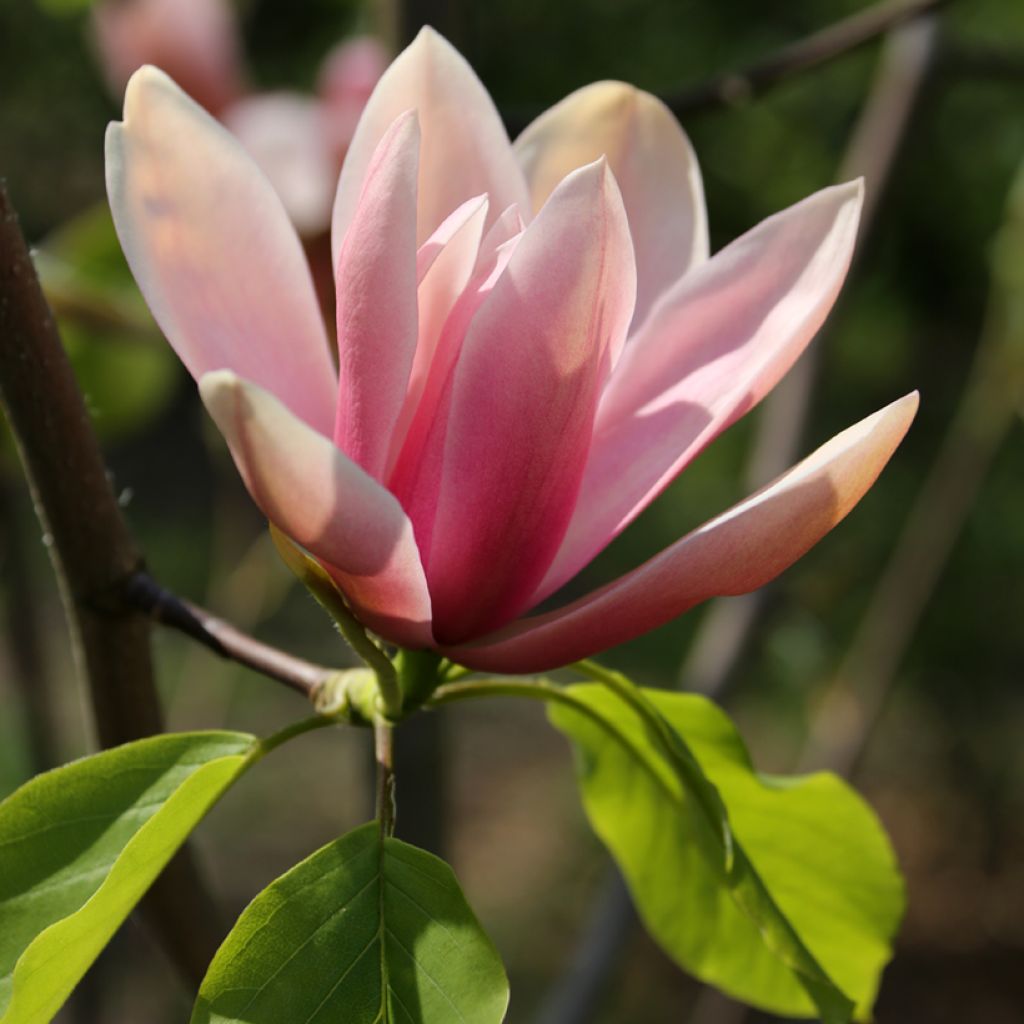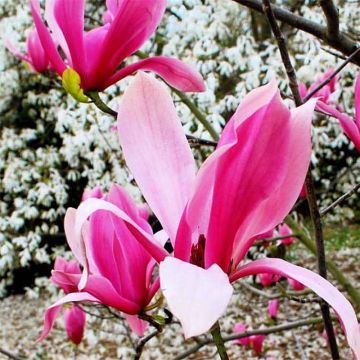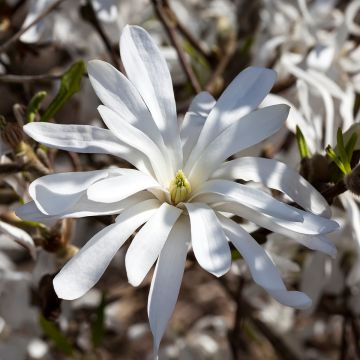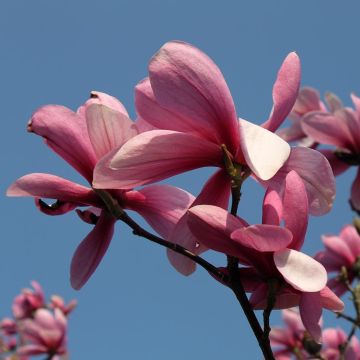

Magnolia Coral Reef
Magnolia Coral Reef
Magnolia Coral Reef
Special offer!
Receive a €20 voucher for any order over €90 (excluding delivery costs, credit notes, and plastic-free options)!
1- Add your favorite plants to your cart.
2- Once you have reached €90, confirm your order (you can even choose the delivery date!).
3- As soon as your order is shipped, you will receive an email containing your voucher code, valid for 3 months (90 days).
Your voucher is unique and can only be used once, for any order with a minimum value of €20, excluding delivery costs.
Can be combined with other current offers, non-divisible and non-refundable.
Why not try an alternative variety in stock?
View all →This plant carries a 24 months recovery warranty
More information
We guarantee the quality of our plants for a full growing cycle, and will replace at our expense any plant that fails to recover under normal climatic and planting conditions.
Would this plant suit my garden?
Set up your Plantfit profile →
Description
The Magnolia 'Coral Reef' is a spring-flowering variety, in April and May, on bare branches at first, then accompanied by the emerging light green foliage. It produces large fragrant cup-shaped flowers, pink with a touch of salmon orange, giving it its distinctive coral hue. Its large pointed leaves turn coppery bronze in autumn. It forms a small tree with a pyramidal habit. Hardy, this Magnolia requires an acidic to neutral soil, a bit of moisture at the roots, and a sunny to semi-shady exposure.
The Magnolias make up the most important genus in the relatively unknown Magnoliaceae family, which also includes the Liriodendron (Tulip Tree) and perhaps a few other genera, as botanists do not all agree on the classification of this family of archaic plants, easily recognisable by their flowers with stamens and pistils arranged in a spiral rather than in concentric circles as in more advanced plants, and with petals and sepals that are morphologically similar, so they are referred to as tepals. The name Magnolia was given to it in 1703 by Charles Plumier, botanist to King Louis XIV, in homage to the physician-botanist Pierre Magnol (1638-1715), who was one of the directors of the Botanical Garden of Montpellier at the end of the 17th century.
The Magnolia 'Coral Reef' forms a tree with a pyramidal habit, with a spreading crown over time, reaching 5 to 6 m in height and 6 to 7 m in width at maturity. Its flowers first bloom alone, then with the young foliage, in April and May, in large upright tulips, predominantly coral pink in colour. The beautiful smooth green leaves, obovate, appear gradually afterwards. Hardy down to -20°C, it prefers slightly acidic and moist soils, not tolerating drought well. It can tolerate full sun and can also grow in partial shade.
The Magnolia 'Coral Reef' is an elegant small tree with spring interest, its large tulip-like flowers catching the eye. It is very suitable for small gardens due to its modest size. Plant this tree as a focal point in the garden. It can also be paired with a mass of large shrubs with summer or winter interest such as Japanese maples, flowering dogwoods (Cornus), witch hazels (Hamamelis). It also pairs well with acid-loving plants such as Rhododendrons, Camellias, Pieris... Since its root system is not harmful to foundations, it can be planted against the wall of a house.
Magnolias are ancient trees, with fossils dating back over 20 million years. Their magnificent flowering is considered one of the most primitive: their flowers are, from an evolutionary perspective, similar to the earliest existing flowers. The bark of magnolias has medicinal properties and is used in cosmetics, while their wood is considered valuable.
Report an error about the product description
Magnolia Coral Reef in pictures


Plant habit
Flowering
Foliage
Botanical data
Magnolia
Coral Reef
Magnoliaceae
Cultivar or hybrid
Other Magnolia
View all →Planting and care
The 'Coral Reef' magnolia prefers sheltered locations, sunny to partially shaded exposures, a moist, well-drained, rich, neutral or acidic soil. It is not demanding in terms of soil quality. However, it does not tolerate overly dry soils, windy locations, or root competition, as its root system is shallow. It is hardy as an adult, but it is advisable to protect young plants from heavy frosts in the first few years after planting. Late frosts and cold winds can damage flower buds and young leaves, affecting flowering.
Planting the Magnolia can be done in spring or autumn, outside the frost period, making sure to place it in a sheltered spot away from cold winds. Prepare a planting hole 80 cm wide and equally deep, with a generous amount of heather soil and compost. Be gentle when placing the plant in the hole to avoid breaking the fleshy yet fragile roots. Water immediately with non-calcareous water (rainwater) to settle the soil around the roots.
During the first year after planting, the Magnolia requires watering once a week. It will benefit from an annual amendment in spring. Mulching the base of the plant is recommended to retain moisture during the hot season, enrich the soil, and protect it from winter cold. Due to its fragile roots, transplanting should be avoided. The only enemies of the Magnolia are pests such as scale insects, snails, and slugs, which can sometimes cause significant damage to young plants, as well as fungal diseases such as root rot (in waterlogged soil), coral disease, and Pestalozzia. It is worth noting that magnolias are ornamental trees that tolerate atmospheric pollution well.
Planting period
Intended location
Care
This item has not been reviewed yet - be the first to leave a review about it.
Similar products
Haven't found what you were looking for?
Hardiness is the lowest winter temperature a plant can endure without suffering serious damage or even dying. However, hardiness is affected by location (a sheltered area, such as a patio), protection (winter cover) and soil type (hardiness is improved by well-drained soil).

Photo Sharing Terms & Conditions
In order to encourage gardeners to interact and share their experiences, Promesse de fleurs offers various media enabling content to be uploaded onto its Site - in particular via the ‘Photo sharing’ module.
The User agrees to refrain from:
- Posting any content that is illegal, prejudicial, insulting, racist, inciteful to hatred, revisionist, contrary to public decency, that infringes on privacy or on the privacy rights of third parties, in particular the publicity rights of persons and goods, intellectual property rights, or the right to privacy.
- Submitting content on behalf of a third party;
- Impersonate the identity of a third party and/or publish any personal information about a third party;
In general, the User undertakes to refrain from any unethical behaviour.
All Content (in particular text, comments, files, images, photos, videos, creative works, etc.), which may be subject to property or intellectual property rights, image or other private rights, shall remain the property of the User, subject to the limited rights granted by the terms of the licence granted by Promesse de fleurs as stated below. Users are at liberty to publish or not to publish such Content on the Site, notably via the ‘Photo Sharing’ facility, and accept that this Content shall be made public and freely accessible, notably on the Internet.
Users further acknowledge, undertake to have ,and guarantee that they hold all necessary rights and permissions to publish such material on the Site, in particular with regard to the legislation in force pertaining to any privacy, property, intellectual property, image, or contractual rights, or rights of any other nature. By publishing such Content on the Site, Users acknowledge accepting full liability as publishers of the Content within the meaning of the law, and grant Promesse de fleurs, free of charge, an inclusive, worldwide licence for the said Content for the entire duration of its publication, including all reproduction, representation, up/downloading, displaying, performing, transmission, and storage rights.
Users also grant permission for their name to be linked to the Content and accept that this link may not always be made available.
By engaging in posting material, Users consent to their Content becoming automatically accessible on the Internet, in particular on other sites and/or blogs and/or web pages of the Promesse de fleurs site, including in particular social pages and the Promesse de fleurs catalogue.
Users may secure the removal of entrusted content free of charge by issuing a simple request via our contact form.
The flowering period indicated on our website applies to countries and regions located in USDA zone 8 (France, the United Kingdom, Ireland, the Netherlands, etc.)
It will vary according to where you live:
- In zones 9 to 10 (Italy, Spain, Greece, etc.), flowering will occur about 2 to 4 weeks earlier.
- In zones 6 to 7 (Germany, Poland, Slovenia, and lower mountainous regions), flowering will be delayed by 2 to 3 weeks.
- In zone 5 (Central Europe, Scandinavia), blooming will be delayed by 3 to 5 weeks.
In temperate climates, pruning of spring-flowering shrubs (forsythia, spireas, etc.) should be done just after flowering.
Pruning of summer-flowering shrubs (Indian Lilac, Perovskia, etc.) can be done in winter or spring.
In cold regions as well as with frost-sensitive plants, avoid pruning too early when severe frosts may still occur.
The planting period indicated on our website applies to countries and regions located in USDA zone 8 (France, United Kingdom, Ireland, Netherlands).
It will vary according to where you live:
- In Mediterranean zones (Marseille, Madrid, Milan, etc.), autumn and winter are the best planting periods.
- In continental zones (Strasbourg, Munich, Vienna, etc.), delay planting by 2 to 3 weeks in spring and bring it forward by 2 to 4 weeks in autumn.
- In mountainous regions (the Alps, Pyrenees, Carpathians, etc.), it is best to plant in late spring (May-June) or late summer (August-September).
The harvesting period indicated on our website applies to countries and regions in USDA zone 8 (France, England, Ireland, the Netherlands).
In colder areas (Scandinavia, Poland, Austria...) fruit and vegetable harvests are likely to be delayed by 3-4 weeks.
In warmer areas (Italy, Spain, Greece, etc.), harvesting will probably take place earlier, depending on weather conditions.
The sowing periods indicated on our website apply to countries and regions within USDA Zone 8 (France, UK, Ireland, Netherlands).
In colder areas (Scandinavia, Poland, Austria...), delay any outdoor sowing by 3-4 weeks, or sow under glass.
In warmer climes (Italy, Spain, Greece, etc.), bring outdoor sowing forward by a few weeks.




























































